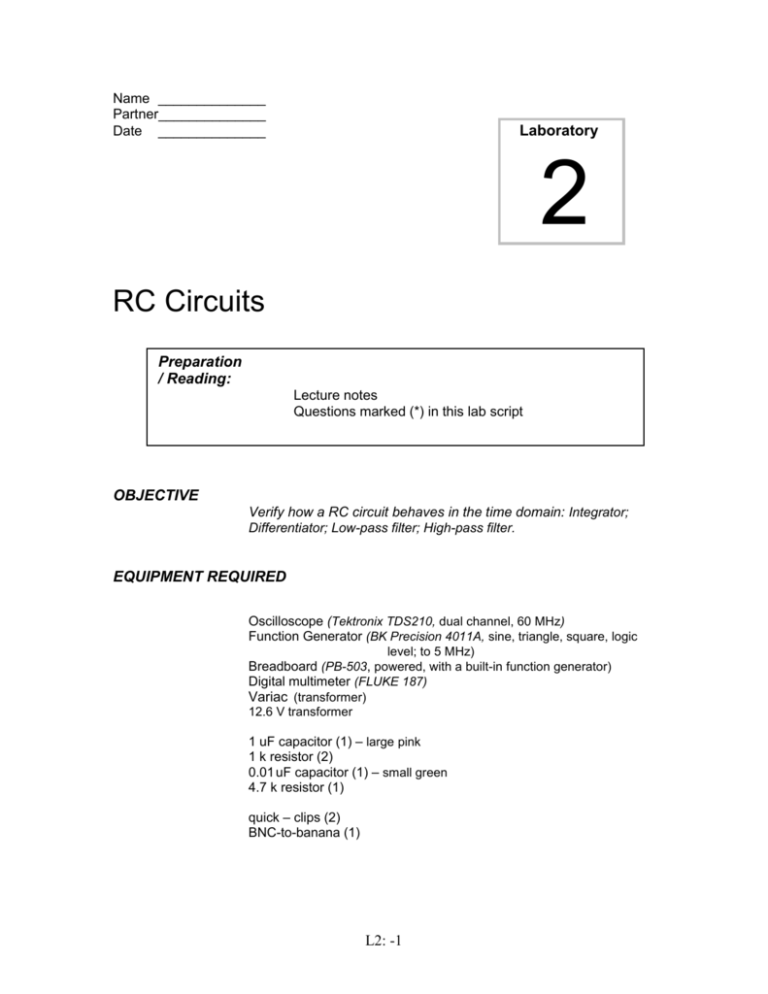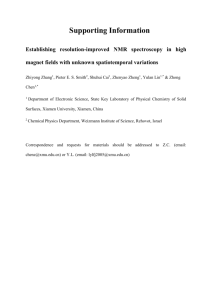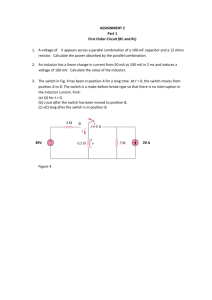07LAB2
advertisement

Name ______________ Partner______________ Date ______________ Laboratory 2 RC Circuits Preparation / Reading: Lecture notes Questions marked (*) in this lab script OBJECTIVE Verify how a RC circuit behaves in the time domain: Integrator; Differentiator; Low-pass filter; High-pass filter. EQUIPMENT REQUIRED Oscilloscope (Tektronix TDS210, dual channel, 60 MHz) Function Generator (BK Precision 4011A, sine, triangle, square, logic level; to 5 MHz) Breadboard (PB-503, powered, with a built-in function generator) Digital multimeter (FLUKE 187) Variac (transformer) 12.6 V transformer 1 uF capacitor (1) – large pink 1 k resistor (2) 0.01 uF capacitor (1) – small green 4.7 k resistor (1) quick – clips (2) BNC-to-banana (1) L2: -1 Lab 2-1: RC Circuit I * 1. Construct the circuit below (Fig. 2.1), using as an input a 0 to 3 V square wave from the function generator at a frequency of 100 Hz. Set the scope to trigger externally from the function generator at a sweep rate of 1 ms/div. Set both channels at 1 V/div with dc coupling setting (Why you should not use the AC coupling setting? Remember what you learned in the previous lab?). Fig. 2.1 2. Place both scope probes on the input to the circuit. Use the scope to fine-tune the frequency to 100 Hz. (What you should see is one cycle of the square wave, with an amplitude of three divisions, in each channel. Set the “vertical” controls on the scope so that ground on both channels is in the middle of the screen. Adjust the trigger-level if necessary so that the display is stationary, and starts with the positive-going half of the cycle.) * 3. Now, take one of the scope probes and place it on the output of the circuit. It should resemble the input, which you can still see on the other channel, but it will be distorted, taking some time to rise to the 3 V input voltage level, and then to fall to the 0 V input voltage level. The time it takes to rise or fall to within 1/e (corresponding to the output to climb from 0% to 63% or to drop from 100% to 37%, respectively) of the final constant voltage level is the “time constant” of the circuit. Calculate the time constant of the circuit. RC (calculated) = _________ Check the rise and fall time on the scope screen, do they equal to each other? Compare with your calculated value of RC. (You may increase the sweep speed of the scope to 0.2 ms/div so that you can see the rise time in more detail. Change the slope on the external trigger and readjust the level, so that you can see the fall time.) 4. Change the frequency of the function generator to 500 Hz, and return the sweep rate of the scope to 1 ms/div. Each positive half cycle of the square wave is now one time constant long, and so is each negative half cycle. Examine the output at different sweep rates. L2: -2 Sketch the waveform you observe. (sweep rate = ) 5. Change the frequency of the function generator to 5 kHz, and adjust the sweep rate of the scope accordingly. This frequency is so high, and the time within a half cycle so short, that the output hardly has time to change at all. Sketch the waveform you observe, and indicate its dc level (what is its dc level?). (sweep rate = ) * 6. What is the input impedance presented to the signal generator by the circuit (assume no load at the output) at dc? At infinite frequency? (NOTE : Questions like this become important when the signal source is less ideal than the function generators you are using. Try to get used to quick worst-case impedance calculations, which is more useful than exact and frequency-dependent calculations.) L2: -3 * 7. The RC circuit I in Fig. 2.1 can be approximately or conditionally used as an integrator, when the Vout is much smaller than the Vin, why? Then, we need to limit the input frequency for a given RC, why? (When we meet operational amplifiers in the future studies, we will see how to make “perfect” integrators --those that let us lift the restrictions we have imposed on the RC version.) L2: -4 Lab 2-2 RC Circuit II 1. Connect the circuit in Fig. 2.2, and repeat the measurements as mentioned in part 1 step 1-5 above. Sketch the waveforms at 100 Hz, 500 Hz and 5 kHz. (Note that Fig.2.1 and Fig.2.2 can both be considered as voltage dividers. At very high frequencies the capacitor looks like a short circuit, or a closed switch. At very low frequencies the capacitor looks like an open circuit, or an open switch. Using this concept of a capacitor is a good way to understand the circuit response at high and low frequencies.) Fig. 2.2 100 Hz (sweep rate = 500 Hz ) (sweep rate = 5 kHz ) (sweep rate = ) * 2. What is the input impedance presented to the signal generator by the circuit (assume no load at the output) at dc? and at infinite frequency? L2: -5 * 3. The RC circuit II in Fig. 2.2 could be considered as an conditional differentiator, if dVout/dt much smaller than dVin/dt. Then, too large RC tends to violate this restriction. Why? (When we meet operational amplifiers in the future studies, we will see how to make “perfect” differentiators --those that let us lift the restrictions we have imposed on the RC version.) L2: -6 Lab 2-3 Low-pass filter 1. Use the circuit in Fig.2.1 again, but replace the square wave input with a 3 V p-p sine-wave input. Look at both the input and output, with the two scope probes. Slowly increase the input frequency from 50 Hz to 500 Hz (select about 10 frequencies), record the attenuation (the ratio of the output voltage to the input voltage) as a function of the frequency. (This circuit is called a “low-pass filter”, which means that as you move to higher frequencies the output voltage decreases. Because at higher frequencies the impedance of the capacitor decreases, so output becomes a smaller fraction of input. We say the “attenuation” of the circuit gets greater at higher frequencies.) f ( Hz ) | Vout ( Volts, p-p value ) Vout/Vin ----------------------------- |------------------------------------------------| | | | | | | | | | | | | | * 2. At what frequency is the signal reduced to about 70% of its original amplitude? What is your calculated “the 3dB point” frequency? f3dB (calculated) = ________ 3. Find the f3dB experimentally: measure the frequency at which the filter attenuates by 3 dB. f3dB (measured) = ________ 4. Sketch the attenuation vs frequency curve (from 50 Hz to 500 Hz) based on your data, including “the 3dB point”. L2: -7 * 5. What is the phase shift at 3dB frequency? What is the limiting phase shift at very high frequencies? and at very low frequencies? 6. You may try to observe phase shift on the scope. (You may use the function generator’s TTL output to drive the scope’s External Trigger. That will define the input phase cleanly. Then use the scope’s sweep rate so as to make a full period of the input waveform use exactly 8 divisions. The output signal, viewed at the same time, should reveal its phase shift readily.) Lab 2-4 High-pass filter 1. Use the circuit in Fig.2.2 again, but replace the square wave input with a 1Vp-p sine-wave input. This is a “high-pass filter”, so that the response is lower at lower frequencies. As in part 3, slowly increase the frequency from 50 Hz to 500 Hz, and look at the output. Does the output make sense? * 2. At what frequency is the signal reduced to about 70% of its original amplitude? What is your calculated “the 3dB point” frequency? f3dB (calculated) = ________ 3. Find the f3dB experimentally: measure the frequency at which the filter attenuates by 3dB. f3dB (measured) = ________ 4. Check to see if the output amplitude at low frequencies (well below the 3dB point) is proportional to the frequency, by measuring 3-4 points. f ( Hz ) | Vout ( V, p-p value ) Vout/Vin ----------------------------- |------------------------------------------------| | | | | L2: -8 Sketch Vout/Vin vs f curve based on your data. Lab 2-5 Filter application -- Selecting signal from signal plus noise 1. Now we are going to try high-pass filter to prefer one frequency range in a composite signal, formed as shown in Fig. 2.3. First of all, adjust the Variac (transformer) in connection with the 12.6 V transformer to make the later output = 6.3 Vrms. Use DMM (set to AC) to monitor the output voltage while adjust the Variac. (CAUTION: Do not connect any instruments to the primary sides of the transformers!) 2. Connect the circuit as Fig. 2.3. We have composite signal consisting of two sine waves from the function generator (set to 1Hz, 4 Vpp) and the transformer. The transformer adds a large 60 Hz sine wave (peak value about 10 V) to the output of the function generator. Connect a highpass filter shown in Fig.2.4. If you are not sure where is the ground, ask your instructor to check your circuit before turn on the power. Then, run the composite signal through the highpass filter. (The 1k resistor protects the function generator in case the composite output is accidentally shorted to ground. The two transformers serve two purposes --- they reduce the 110 Vrms to a more reasonable 6.3 Vrms, and it “isolates” the circuit we are working on from the power line.) Fig. 2.3 Fig.2.4 * 3. Look at the resulting signal after the filtering. What is the filter’s 3dB point? Why was the 3dB frequency chosen where it was? L2: -9 4. Is the attenuation of the 60 Hz waveform about what you expect? Discuss your observations. Here, the 60 Hz is considered “noise”. (In fact, this is the most common and troublesome source of noise in the lab.) L2: -10









